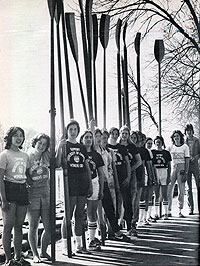 From
our pages
From
our pages
1911
The University sponsored a spring lecture series on "recent
developments in variation, heredity, and evolution, and the application
of this new knowledge to plant, animal, and human development
and improvement." Speakers from the Chicago faculty, Harvard
University, and the Carnegie Institute discussed plant genetics
("Inheritance and Evolution in Higher Plants" and "The
Cytological Evidences of Germ Constitution and Modifications").
Lectures on human development featured such topics as "Variation,
Heredity, and Their Relation in the Production and Perfection
of New Races" and "Inheritance of Physical and Mental
Traits in Man, and Their Application to Eugenics." The lectures
were to be issued in book form by the U of C Press.
1951
With funding from Leo Wallach, the University of Chicago Hospitals
opened a laboratory to study ulcerative colitis, a disease of
then unknown causes. Wallach, a partner in the Fort Dearborn Hotel,
also solicited the help of friends and business associates to
purchase drugs for ulcerative colitis patients unable to afford
medications. His interest in ulcerative colitis began when his
son, a physician, became ill with the disease.
 1976
Chicago women brought a new sport to the Midway: crew. The club
sport, formed by undergraduate Barbara Horung and Lab Schools
teacher Laurie Moses, had its first meet in April, defeating the
Milwaukee Women's Rowing Club. Traveling to Boston for the Head
of the Charles Regatta, the young team's four-woman crew came
in 27th out of 37. The team also spent time fund-raising, embarking
on a campaign to raise $10,000-$6,000 for an eight-oar shell and
blades and $4,000 to defray travel expenses and buy a better four-oar
boat.
1976
Chicago women brought a new sport to the Midway: crew. The club
sport, formed by undergraduate Barbara Horung and Lab Schools
teacher Laurie Moses, had its first meet in April, defeating the
Milwaukee Women's Rowing Club. Traveling to Boston for the Head
of the Charles Regatta, the young team's four-woman crew came
in 27th out of 37. The team also spent time fund-raising, embarking
on a campaign to raise $10,000-$6,000 for an eight-oar shell and
blades and $4,000 to defray travel expenses and buy a better four-oar
boat.
1991
Based on the results of an eight-year, 108-person study, hypertension
specialist William Elliott, PhD'76, MD'79, proposed a link between
creases in human earlobes and heart disease. Elliott, an assistant
professor in medicine and pharmacological & physiological
sciences, found that individuals with a crease in at least one
earlobe were much more likely to die from heart disease than those
whose ears were crease-free. The earlobe-heart mechanism was unclear,
but Elliott suggested several possible explanations, including
the loss of elastin, which both causes creasing in the earlobe
and contributes to the hardening of arteries.-Q.J.

![]()
 From
our pages
From
our pages 1976
Chicago women brought a new sport to the Midway: crew. The club
sport, formed by undergraduate Barbara Horung and Lab Schools
teacher Laurie Moses, had its first meet in April, defeating the
Milwaukee Women's Rowing Club. Traveling to Boston for the Head
of the Charles Regatta, the young team's four-woman crew came
in 27th out of 37. The team also spent time fund-raising, embarking
on a campaign to raise $10,000-$6,000 for an eight-oar shell and
blades and $4,000 to defray travel expenses and buy a better four-oar
boat.
1976
Chicago women brought a new sport to the Midway: crew. The club
sport, formed by undergraduate Barbara Horung and Lab Schools
teacher Laurie Moses, had its first meet in April, defeating the
Milwaukee Women's Rowing Club. Traveling to Boston for the Head
of the Charles Regatta, the young team's four-woman crew came
in 27th out of 37. The team also spent time fund-raising, embarking
on a campaign to raise $10,000-$6,000 for an eight-oar shell and
blades and $4,000 to defray travel expenses and buy a better four-oar
boat.